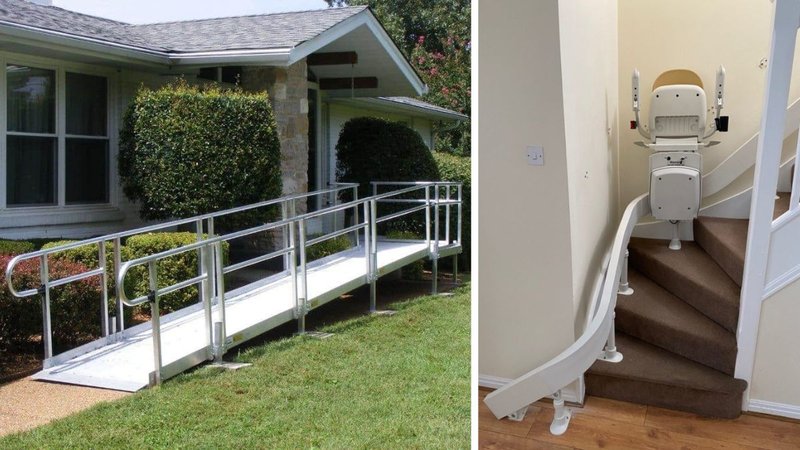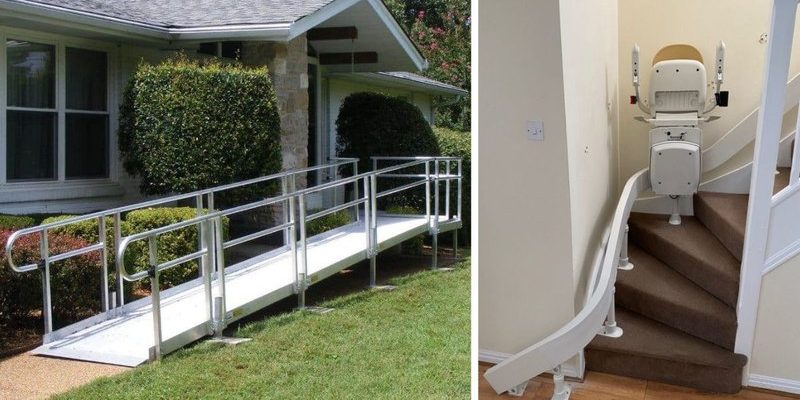
Honestly, you might not even notice thresholds if you don’t use a mobility device. But for wheelchair users, even a small lip can mean the difference between smooth independence and daily frustration. These details really matter. The good news is there are lots of creative solutions out there. From low-profile ramps to flush transitions, it’s absolutely possible to make every doorway a smooth ride.
A few trusted brands—like EZ-Access, Pemko, and National Guard—have earned a serious following in this space. Whether you’re working with hardwood, tile, sliding doors, or a mix, there’s a threshold solution built for your needs. Let’s break down your options, compare the pros and cons, and talk honestly about how to sync up accessibility and style—without feeling like you’re turning your home into a hospital.
What Makes a Threshold Wheelchair-Friendly?
Here’s the thing: standard thresholds aren’t designed with wheelchairs in mind. They’re often built to keep out drafts or water, not to offer a smooth path. For a threshold to be truly wheelchair-friendly, it needs to be low, stable, and easy to cross—ideally, with no bump at all.
Most building codes say the max rise should be 1⁄2 inch if there’s no ramp and up to 3⁄4 inch if it has a beveled edge. But even these numbers can still feel challenging for some users. That’s why the best threshold options for homes with wheelchair accessibility focus on zero-step or gently-sloped designs.
You might be wondering, “What about weatherproofing—will I lose that if I go flush?” Many premium threshold brands, like Pemko, blend both worlds. Their designs use tightly sealed transitions, so you don’t have to sacrifice energy efficiency for accessibility. In other words, you get smooth rolling without letting the cold air in.
There’s also the little detail of traction. Some thresholds come with textured surfaces or special coatings so wheels, crutches, or even shoes don’t slip. Think of it like resetting the “code” for your doorway—now it’s synced up for everyone’s safety and comfort.
Flush Thresholds: The Smoothest Solution
If you want the simplest, cleanest fix, flush thresholds (sometimes called “zero-step” or “no-lip” thresholds) are where you start. These are exactly what they sound like: the floor continues straight through the doorway with no step or sloped edge, so there’s nothing to trip on or roll over.
Here’s where flush thresholds really shine. They’re perfect for homes with open floor plans, tile, or hardwood, and they blend right in—no industrial ramp look. Brands like Pemko and National Guard offer flush models in aluminum or durable rubber that look almost invisible once installed.
Of course, there are some caveats. If your home is older with uneven floors, getting a flush threshold might mean a little extra work—like adjusting subfloor heights. And while flush makes rolling a breeze, you have to make sure the seal keeps out water and drafts. The best flush models use hidden gaskets and high-performance materials to handle that.
For anyone doing a major remodel or new build, flush thresholds are honestly the gold standard for wheelchair accessibility. They set the stage for easy, independent movement throughout the home—no need for workarounds or “tricks” to get through the doorway.
Beveled Threshold Ramps: Instant Upgrades
Let’s say ripping out your floors isn’t an option (or you just want a quick fix). That’s where beveled threshold ramps come in. These are wedge-shaped add-ons that bridge the gap between uneven floors or raised thresholds. It’s like syncing two levels of your home so wheels glide right across—no more power struggles at every doorway.
You’ll find beveled ramps in all shapes and sizes. Some, like the highly-rated EZ-Access Transitions series, are portable and made of lightweight aluminum or rubber. These can be placed over most standard thresholds in seconds, with no tools or permanent changes. Other models can be trimmed down to fit custom heights and widths—seriously handy if your doorways don’t follow the usual rules.
Here’s the insight: beveled ramps are perfect for renters, people with temporary mobility needs, or anyone who doesn’t want to commit to a full remodel. They also come in colors and finishes that can blend in nicely, so you’re not announcing “wheelchair fix” to the world. Just remember to double-check the height and slope to match ADA guidelines—too steep, and it’s back to square one.
Beveled threshold ramps are the universal remote of accessibility solutions—quick, versatile, and ready to work almost anywhere.
Rubber Thresholds: Quiet, Slip-Resistant, and Ultra-Durable
Sometimes, you want a solution that’s tough, subtle, and basically maintenance-free. Rubber threshold ramps are a top pick for a reason. Instead of cold metal or complicated installations, these ramps offer a gentle, slip-resistant path right where it’s needed most.
EZ-Access and AliMed both make rubber ramps that come in different heights (usually 1⁄2 inch to 2 inches) and can be trimmed for a perfect fit. You just drop them into place—no need to reset your entire hallway or sync a dozen parts. They even stand up to heavy traffic, won’t shift out of place, and are quiet under wheels.
Here’s what stands out with rubber: they’re great for both indoor and outdoor thresholds. If you’ve got a sliding door to a patio, or uneven stonework leading outside, a rubber ramp can bridge the gap without rotting, warping, or getting slippery when wet. Plus, they almost disappear visually, especially on dark floors.
There are a few things to consider. Rubber ramps can have a faint odor at first, and they’re heavier than you might think—so moving them around takes a bit of muscle. But for most people, that’s a small tradeoff for such a smooth, safe transition.
Metal Threshold Plates: Low-Profile and Heavy-Duty
If your doorway sees a lot of action or you need extra support for power wheelchairs, a metal threshold plate might be the answer. These are thin plates (usually aluminum or stainless steel) that sit over the threshold, creating a stable, low-rise path.
Honestly, these are like the “reset button” for tough doorways. Aluminum threshold plates are incredibly strong, can handle a ton of weight, and won’t wear down with constant use. Models from Pemko and National Guard often have ribbed or grooved surfaces for extra grip.
Metal threshold plates work best indoors, especially for slightly raised transitions between carpet and tile, or where the floor height changes are minor (under 3⁄4 inch). For bigger steps, you’ll want a ramp instead. Installation usually means screwing the plate down or using heavy-duty adhesive, so they’re not as temporary as rubber or portable ramps.
One thing to watch for: metal can get slick, especially if it’s wet. Always look for plates with anti-slip finishes or raised traction. And yes, they’ll change your floor’s look a little—though many models come in brushed finishes that blend nicely with modern or classic décor.
Meeting ADA Guidelines: Why Slope and Height Matter
Let me explain why you can’t just grab any threshold fix and call it a day. The ADA (Americans with Disabilities Act) sets clear rules for how tall a threshold can be, how steep a transition should feel, and what kind of surface is safe for wheelchair use. Following these guidelines isn’t just a “nice to have”—it’s essential for true accessibility (and sometimes for legal code compliance, too).
Here’s what to look for:
- Threshold height: No more than 1⁄2 inch high with a square edge; up to 3⁄4 inch if beveled.
- Slope: For rises over 1⁄2 inch, the slope must be gentle—at least 1:12 (for every inch of rise, at least 12 inches of ramp).
- Traction: Surfaces must be slip-resistant, even when wet.
If you’re pairing a new threshold with an entrance ramp (universal or custom), double-check for smooth transitions—no lips or “code mismatches” that could snag wheels or cause trips. Brands like EZ-Access clearly mark their products as ADA-compliant, making the troubleshooting process a lot simpler.
A threshold that “almost” meets ADA isn’t enough. It’s like syncing a remote but leaving one button unprogrammed—frustrating and incomplete.
Choosing the Right Option for Your Home and Lifestyle
Honestly, picking the best threshold option for homes with wheelchair accessibility is a bit like choosing a new pair of shoes—you need the right fit, style, and function for your day-to-day life. Not every home (or user) needs the same solution. Here’s how to break it down:
- Permanent or temporary? If you’re remodeling, flush or metal thresholds look best and work for the long haul. If you’re renting or want flexibility, portable rubber or beveled ramps make more sense.
- Indoor or outdoor? Aluminum and rubber ramps both weather well, but some materials (like wood) may not last on patio doors or in damp climates.
- Style and finish: Today’s options go way beyond “hospital chic.” Look for colors and textures that match your floors—you can sync accessibility with style.
- Your mobility needs: Power chairs, scooters, and even walkers may need wider or higher-capacity ramps. Check the specs before you buy.
If you’re still not sure, start with one doorway—the one you use most—and see how an upgrade feels. Sometimes even a single ramp or plate makes a huge difference to your daily routine. There’s no shame in trying out a few options to troubleshoot what works best for your floors, doors, and life.
Final Thoughts: Small Changes, Big Impact
Making your home more wheelchair accessible doesn’t have to mean tearing everything apart or settling for ugly, industrial fixes. There are so many well-designed, thoughtful threshold options out there now that blend right in. You’re not just syncing a new piece of hardware—you’re opening up freedom and independence for yourself or someone you care about.
From flush transitions that make your floors feel seamless, to rubber ramps that handle weather and wear, every solution has its perks. Don’t be afraid to mix and match throughout your home. Sometimes, just tweaking one threshold can reset your whole experience.
If you’re overwhelmed, remember: you’re not alone. Brands like EZ-Access, Pemko, and National Guard have made troubleshooting these barriers their whole mission. It’s okay to lean on their expertise, ask for samples, or consult with local accessibility pros.
At the end of the day, the best threshold option for homes with wheelchair accessibility is the one that actually makes life easier for the people living there. A small change underfoot can unlock so much more comfort, confidence, and control—everywhere you want to go.
